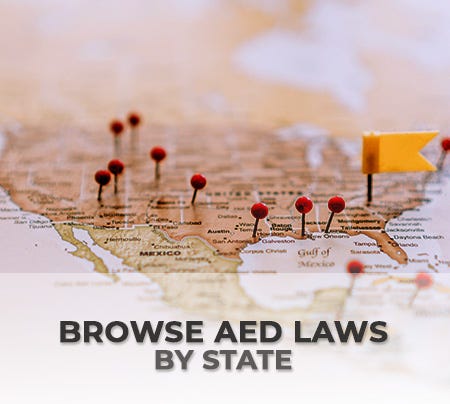Welcome to AED Laws and Legislation!
Sudden cardiac arrest can happen to anyone, anywhere, and at any given time, which is why it's recommended (and often the law) that public locations have automated external defibrillators, also called AEDs, nearby or on-site. Use the AED Laws and Legislation resource to understand the legal requirements in your state or industry to help ensure the compliance and effectiveness of your AED program.

What type of laws and legislation are there?
Many states have legislation to help ensure owners are following through on their responsibility in owning their AED. There are some laws that require certain industries and places such as schools, gyms, or large facilities to carry an AED on-site. Many workplaces and businesses follow OSHA and federal laws, which also contain many AED or AED-related regulations that consider AED placement and the AED training that must be adhered to.
What are the ramifications of not following AED laws?
You can protect yourself and your industry from civil liability by being compliant with your state's AED laws. Code liability protections are crucial for the health and safety of your community. AED programs that help with the management and compliance of your AED along with public access defibrillation (PAD) programs and policies, can work to ensure that AEDs are available for a person or entity to use if needed. When an AED is required and there is not one available, you or your business have the potential of being held liable for an employee or patrons' cardiac death.
Why is it important to keep up with AED laws and regulations?
Current events, for example, the NFL's Damar Hamlin's sudden cardiac arrest or a major airline failure to follow AED FAA guidelines, influence AED laws to be passed in some states and industries. We want to help ensure you're keeping up with these laws and regulations as they tend to move rapidly through the legislative process and could affect the compliance of your emergency medical services system. It is also recommended to have the appropriate training and medical oversight. AED training paired with cardiopulmonary resuscitation (CPR) training and a basic first aid course can benefit your staff's readiness when implementing an AED program.
New AED Laws

Washington State: Mandatory AED Placement in Fitness Centers
Prompted by the death of a Thurston County Search and Rescue Captain, the new Washington State law, Senate Bill 5592, mandates that all fitness centers in the state must have at least one semi-automatic external defibrillator (AED) on-site.

Florida: Bill Requires Youth Coaches to Have CPR and AED Training
Effective July 1, 2024, a new Florida law requires youth athletic coaches to undergo CPR training every 2 years to enhance child safety. This bill also ensures the presence of AEDs at all sporting events in public K-12 schools to address sudden cardiac arrest, a leading cause of death among student-athletes.












 CALL US:
CALL US: